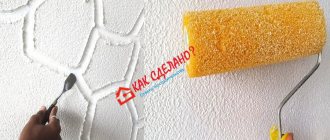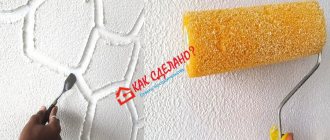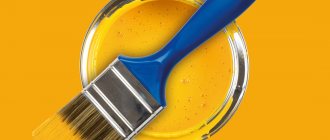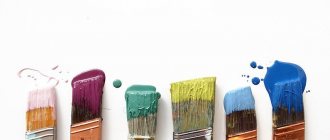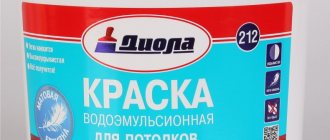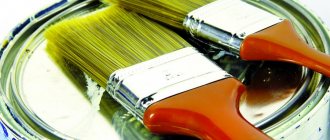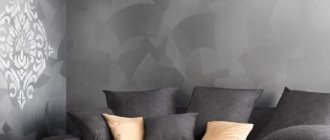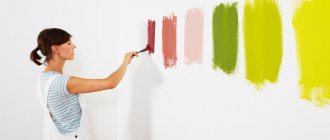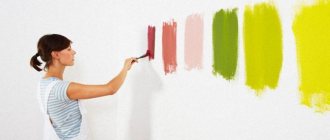Modern repair technologies help achieve original effects on various surfaces using a wide range of finishing materials. A popular finishing method is the use of textured paint in the interior. It is a liquid base to which various components, such as fillers and colors, are added as needed. In this article we will figure out how to apply textured wall paint with your own hands, its pros and cons.
Relief texture with different effects
There are many ways in which you can imitate the texture of natural materials, such as stone, leather or brick. In this article we will talk about the pros and cons of texture, properties and components, as well as the basic techniques for applying the composition.
Relief texture with different effects
Textured paints have become popular because they have a number of undeniable advantages:
- the coating hides minor wall defects and therefore does not require careful surface preparation;
- has high hardness (used as anti-vandal);
- water and weather resistant;
- vapor permeable - the walls will “breathe”;
- can be used on facades and for interior decoration.
Textured paint for walls: features and photo examples in the interior
Textured paint is a decorative coating based on acrylic and polymer components that give the surface a beautiful relief appearance. Its consistency is more like putty. Many formulations contain special additives that speed up the drying time of the layer to 1-2 hours.
The beautiful effect on the surface and the play of shadows appear in natural or artificial light. To apply it, you do not need to level the walls to perfection; it is enough to fill large uneven areas and then apply a textured effect.
How to paint wallpaper?
What nuances should be taken into account when combining wallpaper and paint? First of all, this is the choice of wallpaper for painting, which must be approached quite seriously, since it is assumed that the paint should be long-lasting and durable, and repainting is not excluded.
Features of each type of wallpaper:
Embossed paper wallpaper is inexpensive, repels moisture, environmentally friendly, but short-lived.
Non-woven wallpaper is also quite inexpensive, but more durable. They stick well and wash well. Since most non-woven wallpaper has an uneven surface, when painting it is better to use a hard brush rather than a roller.
Fiberglass wallpaper is the most durable type. They tolerate any mechanical stress and moisture.
Getting to know the nuances of combined coloring of a room gives you the opportunity for independent creativity and design decisions. Now you know how to paint walls in 2 colors so that the quality of surfaces painted with different materials perfectly matches the rest of the objects in the interior.
What types of textured paint are there for wall decoration?
To decorate walls, a wide variety of textures are used, which differ in composition, types of textures and color.
Types of textured paint for interior decoration
The main criterion for choosing textured paint is its base; therefore, finishing materials for interior work are classified into the following varieties.
| Type of texture | Description |
| Vinyl | Has excellent protection against external factors. |
| Acrylic | Water-based, has good plasticity, but is not resistant to ultraviolet radiation. |
| Silicate | The composition includes liquid glass, which protects against external influences. One of the disadvantages is the high consumption of material. |
| Silicone | It has excellent ductility and resistance to mechanical stress. |
| Mineral | It contains cement and has excellent vapor permeability and moisture resistance. For use in exterior finishing it is necessary to include additional additives. |
Before choosing a texture, you should study its properties
Characteristics of textured paint for exterior use
Textured paints are often used for finishing external surfaces; when choosing, you should pay attention to the manufacturer's recommendations on the packaging. They must have:
- waterproof;
- resistance to temperature changes.
Since the layer of texture is thicker, it will take longer to dry, so it is necessary to choose textures that contain special additives that speed up these processes.
The use of textured compositions for exterior finishing has its advantages: a relief coating does not require an ideal base, in addition, it will hide minor irregularities
What kind of material is this
Textured paint is produced in the form of a thick viscous mass based on an acrylic, mineral or silicone binder, which contains fillers that give the surface a relief. It can be colored or white. Mineral compositions for finishing facades can also be sold in the form of a bulk mixture, which is diluted with water.
For reference. In the white version, mainly water-soluble paints are produced, which can be tinted independently using special pigments.
Samples of textures created using textured paint
Walls already finished with it are difficult to distinguish from those on which decorative plaster and ordinary paint have been applied. That is, the effect is almost the same, but applying textured paint with your own hands is much easier and faster.
Types and sizes of filler
Based on the type of particles included in the paint for thickness and relief, they are divided into compositions with the following fillers:
- Granite or marble chips;
- Crushed gas silicate;
- Quartz sand;
- Metal particles with reflective properties;
- Sawdust;
- Natural and synthetic fibers.
They may also contain modified starch and other thickeners, as well as special pigments that give the coating the effect of silk or mother-of-pearl. The shape of these particles is most often scaly or drop-shaped.
Fillers of different fractions
And the depth and severity of the future relief depends on their size:
- Fine-grained paints include paints with a filler diameter of up to 0.5 mm;
- For medium-grained – 0.5-1 m;
- For coarse grains – 1-2 mm.
Application area
Like all other paints and varnishes, textured paints, depending on the composition, can be used for both exterior and interior work. Therefore, before purchasing, you need to read the manufacturer's recommendations.
As for the type of base on which they can be applied, this is:
- Tree;
- Plaster;
- Concrete;
- Brick or stone masonry.
Manufacturers and prices
Despite the fact that this material is relatively new, it is produced by many manufacturers.
The following brands are especially popular among them:
The price depends on many factors: the type of binder and filler, the presence of unique additives, color, manufacturer. It is quite difficult to announce the average cost, since the spread is large.
For reference. For example, a 20-kilogram jar of Prorab Sandeco textured paint from Bayramix costs about 1,500 rubles. The same volume of SuperDecor paint from Balticolor will cost 4,000 rubles. And Arabesco from Clavel is already 9400 rubles.
Paint Foreman Sandeko (Bayramix)
If you want to save money or create something of your own, there is a way to make textured paint with your own hands. To do this, you need to add clean sawdust, granite chips or quartz sand to acrylic paint. The latter are sold in construction stores. But select the initial composition carefully, taking into account where you plan to use it - on the facade or in the interior.
All the pros and cons of textured wall paints
Textured paint is very popular because:
Advantages
- long service life without loss of original characteristics. With proper care, it will last at least 10 years;
- if necessary, you can update the coating, but there is no need to remove the old one;
- hypoallergenic and environmentally friendly;
- you can create a monolithic surface;
- easy maintenance, wet cleaning of the washable surface is allowed;
- versatility - suitable for both living rooms and kitchens.
Flaws
- texture consumption is 1,000 g/m²; when applying several layers, the cost of coating will be high. It is necessary to calculate the painting budget in advance;
- To obtain a high-quality result, leveling the base is required;
- To create an unusual effect, you need certain skills in applying plaster.
Manufacturers produce a huge variety of shades and textures, you can create unusual coatings and bring to life the most daring design solutions
Structural painting tools
Such coatings are available in many colors; a popular solution is to mix white paint with dye. The result depends on which tool we use. Structural paint does not require filling holes, cracks and defects. Painting walls with this coating should begin with a set of necessary tools. You will need:
- Bucket.
- Mixer.
- Grater.
- Sponge, brush, roller.
Decorative possibilities for painting walls with textured paints
Textured coatings are often used to decorate wall and ceiling surfaces in living rooms; they are also perfect for kitchens, corridors and loggias. All structures are classified into standard and coatings with unusual decorative effects.
Standard coating textures
Depending on the components of the textured paint, you can get a variety of decorative relief in the finish.
Mizuri - Composed of modified starch and acrylic components, the coating can have a smooth or wavy surface
Relief - Solid particles in the composition create the effect of bark beetle, smudges, waves, cracking
Marseille wax - The composition includes artificial wax components, thanks to which the structural coating, after drying, acquires the effect of an aged stone
Atacama - The surface has a rough structure thanks to quartz sand, special components give the finishing paint a metallic tint
Shagreen - The texture allows you to achieve uneven painting simulating concrete, metal or ordinary plaster. Outwardly, it resembles sandpaper or orange peel
Exquisite and unusual effects of textured wall paints
For interior decoration of wall surfaces, you can choose textures with an unusual effect.
Wet Silk - Cotton and cellulose fibers give an unusual velvet or silk effect
Mother of Pearl - Pearl shade fills the room with additional light. It is recommended to choose it for rooms with windows facing north - mother-of-pearl visually gives a feeling of warmth and comfort
An unusual effect is given to textured paint by the inclusion of quartz sand, shells or glitter, which creates a rough surface.
Mother-of-pearl dye adds dynamics to the room, creates a certain energy that increases efficiency. The matte finish has a calming effect; in addition, ultraviolet rays scatter when they hit it, thereby hiding minor imperfections in the finish.
Leading manufacturers of decorative textured paints
When choosing textured paints, you need to focus on the manufacturer, since unverified companies may produce a low-quality product, which will affect the finishing result. We can note well-known companies that offer inexpensive formulations with a variety of effects:
- Amourcolor paints are the most popular, they have increased durability and a variety of shades;
- "Lakra" is a Russian manufacturer that produces high-quality relief textures;
- the famous one offers compositions with imitation of aged surfaces, silk, velvet;
- the VGT brand from the Russian Federation produces textures adapted to our climatic conditions;
- "Blancolor" produces durable textures with imitation silk surfaces and waxed plaster.
Paint for textured plaster with a “wet silk” effect
Which is the best textured paint to buy: recommendations for choosing
To avoid any unpleasant surprises when painting walls with textured paint, it is important to choose the right composition. To do this, you should first study the features of each type of coating and accurately determine the texture and desired shade.
Features of choosing washable textured paint for the walls of the kitchen, hallway and bathroom
For bathrooms, you should choose coatings that have increased moisture resistance. There is a high probability of contamination in the kitchen and hallway, so the main criterion is the possibility of wet cleaning. Having studied all the compositions, we can say that preference should be given to acrylic paint - it has excellent characteristics and a rich palette of shades. Using interesting application techniques you can achieve a unique visual effect.
Which textured paint is suitable for living rooms?
For the ceilings of living rooms, silicate textured paint is suitable, provided that the surface is first well leveled. The coating has a translucent structure and will highlight all defects. It should be applied in an even layer without additional relief; it is advisable to choose light shades. And for the walls you can choose a texture with an unusual effect, for example, velvet or wet silk.
How to paint correctly
A home craftsman must have the necessary tools:
- Foam paint roller (for smooth painting) or fur (for structural finishing).
- A set of brushes of different widths.
- Painting ditch. You need to make sure in advance that the dimensions of this container and the roller fit together.
Also, when working, you may need a plastic spatula, masking tape, a mixer for stirring paint, and additional devices for original design ideas. For uniform painting of large surfaces, the use of a spray gun is justified.
To paint walls, in most cases, water-based paint is purchased. After opening a new jar, you should mix the contents thoroughly; if desired, you can add a special pigment to obtain the desired shade.
A roller is used to paint the main part of the surface. During work, you should ensure that excess paint does not fall on its axial part, and that the soft surface is moistened evenly.
Paint is applied to the wall in vertical stripes up to 70 cm, which overlap each other by 5 cm.
When painting walls with your own hands, you should know that one coat of paint is not enough. To obtain a high-quality result, the surface should be painted 2 or 3 times, waiting for the previous layer to completely dry, on average 5 hours.
If the paint is applied in 3 stages, then during the second application the stripes should not be vertical, but horizontal.
Textured paint for exterior finishing
For exterior decoration of buildings, you should choose textured paint, which includes special additives that increase the resistance of the coating to temperature changes, ultraviolet radiation and high humidity. Acrylic compositions fade in the sun, so it is better to avoid them, but vinyl mixtures are just suitable for painting facades. In addition, silicone and silicate textures can be used.
Do-it-yourself textured wall painting: tools and application technology
To apply textured paint with your own hands, brushes, sponges, and various rollers are most often used. During the work process, you should adhere to the same application technology throughout the entire room, otherwise the effect will not be so beautiful.
Roller application technique
Making relief with a sponge
Versatile brush application
Preparatory work before applying textured paint
Before applying textured paint with your own hands, you need to prepare the surfaces. The operating procedure is as follows.
- Lay the film on the floor and secure it to the ceiling with tape to prevent splashes during operation.
- Putty the walls, paying attention to deep cracks and irregularities.
- Coat the surface with an acrylic primer to improve adhesion of the paint to the base. For work it is better to use a roller; the composition should be applied evenly.
The surface is completely cleaned beforehand.
DIY methods for applying textured paint
Before painting walls with textured paint, you must prepare tools that will be used to create a relief to the surface:
- containers for water and paint;
- construction brushes with bristles of varying hardness;
- sponge;
- spatulas, trowels, construction floats;
- brush;
- rollers to create a rough base;
- trowel;
- overalls, glasses, gloves, cap.
The composition should be applied from top to bottom to avoid the formation of smudges. First of all, you should start working from those places that are poorly lit - this is a kind of training before processing the central zones.
Rollers with a textured base to give surface relief
Technique for applying textured paint with a roller and sponge
Let's look at the step-by-step process of applying textured paint for walls with a roller and sponge. First, the composition must be mixed well until it becomes a homogeneous mass.
- Apply white paint evenly onto the wall surface using a medium-nap roller. Drying time - 6-8 hours;
- Soak a natural sponge in cold water and squeeze well;
- Dip the sponge into the composition and apply it using tamponing movements over an area of 1-2 m². The work should take no more than 15 minutes, during which time the coating will dry out a little;
- Moisten the surface with water using a spray bottle;
- Smooth the sharp edges with a spatula using light movements;
- Then you can begin finishing the next section. You need to start from the upper left corner, gradually moving down and to the right. After 6-8 hours the surface will dry, excess protrusions can be removed using sandpaper;
- Wax is used for tinting. To facilitate its application, the surface is moistened with water from a spray bottle. The coating should be applied to an area of 0.5 m² using a brush. Remove excess wax with a spatula;
- The drying time of the decorative coating is 4-6 hours.
Step-by-step application of textured paint with a brush
Let's consider another way to apply a texture with a chameleon effect with a brush. To work, we need a composition in three shades.
- After mixing, the thick paint is applied to the wall using short multidirectional movements using a wide brush;
- The next day the wall is ready for further decoration;
- The remaining two tones must be mixed directly on the wall. To do this, use a brush to apply first one tone, then another, and blend with multidirectional movements on the surface;
- Upon visual inspection from different angles, all shades of the coating appear.
Why is additional processing needed?
After complete drying, you can apply interior varnish or wax to the surface - they will give the relief a more expressive structure. In addition, the additional coating has protective functions against mechanical damage.
Wax gives expressiveness
Application methods
Now let's look at how to apply textured paint using various tools.
Trowel . The paint is applied in the same way as decorative plaster. The technique for creating a drawing can be different. For example, a trowel is pressed against the material, and after it is torn off, a “fur coat” relief remains on the wall. Then the tops of the irregularities are smoothed out a little. Compounds with filler can be simply spread evenly over the surface.
Brush . With short pile, suitable for applying strokes in different directions. A long brush is convenient for decorating walls, adding thin lines to a plain color.
Sponge or foam rubber . Their porous surface leaves small irregularities in the paint. The drawing looks like a stone. Quartz sand in the mixture will add roughness to the coating.
In the photo, the sea sponge is a natural material.
Silicone roller.
Rolling it along the walls or ceiling leaves repeating patterns. You can work with it on a smooth painted surface, or complementing an already created texture.
A fur roller is mainly used for applying paint. The “fur coat” finish he creates is quite boring and is used more often on the basement and facade of houses.
To enhance shine after drying, the surface can be treated with wax for decorative plaster. After 5-10 minutes, the wax is polished with a soft cloth.
Acrylic varnishes (Tikkurila, VGT, Tex, etc.) also create gloss well.
Material consumption, drying time
To correctly calculate the area before painting, you need to follow the paint manufacturer’s instructions and the consumption per 1 m2 indicated therein.
For example, for the VGT / VGT GALLERY textured coating, the consumption is 0.7-1.4 m²/kg. Those. one 18 kg bucket is enough for 13-26 m2 of wall.
Thick material can be diluted with water up to 5% by volume.
The paint dries completely in 48 hours.
